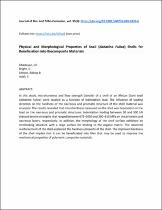 ResearchSpace
ResearchSpace
Physical and morphological properties of snail (Achatina Fulica) shells for beneficiation into biocomposite materials
JavaScript is disabled for your browser. Some features of this site may not work without it.
- ResearchSpace
- →
- Research Publications/Outputs
- →
- Journal Articles
- →
- View Item
| dc.contributor.author |
Gbadeyan, OJ

|
|
| dc.contributor.author |
Bright, G

|
|
| dc.contributor.author |
Sithole, Bishop B

|
|
| dc.contributor.author |
Adali, S

|
|
| dc.date.accessioned | 2020-07-15T10:25:19Z | |
| dc.date.available | 2020-07-15T10:25:19Z | |
| dc.date.issued | 2020-02 | |
| dc.identifier.citation | Gbadeyan, O.J. et al. 2020. Physical and morphological properties of snail (Achatina Fulica) shells for beneficiation into biocomposite materials. Journal of Bio- and Tribo-Corrosion, vol. 35(6): https://doi.org/10.1007/s40735-020-0333-6 | en_US |
| dc.identifier.issn | 2198-4220 | |
| dc.identifier.issn | 2198-4239 | |
| dc.identifier.uri | https://link.springer.com/article/10.1007/s40735-020-0333-6?shared-article-renderer | |
| dc.identifier.uri | https://doi.org/10.1007/s40735-020-0333-6 | |
| dc.identifier.uri | https://rdcu.be/b5AoB | |
| dc.identifier.uri | http://hdl.handle.net/10204/11479 | |
| dc.description | Copyright: 2020 Springer. Due to copyright restrictions, the attached PDF file only contains the abstract of the full text item. For access to the full text item, please consult the publisher's website: https://doi.org/10.1007/s40735-020-0333-6 . A free fulltext non-print version of the article can be viewed at https://rdcu.be/b5AoB | en_US |
| dc.description.abstract | In this study, microhardness and flow strength (tensile) of a shell of an African Giant snail (Achatina Fulica) were studied as a function of indentation load. The influence of loading direction on the hardness of the nacreous and prismatic structure of the shell material was analyzed. The results revealed that microhardness measured on the shell was dependent on the load on the nacreous and prismatic structures. Indentation loading between 50 and 500 kN induced tensile strengths that ranged between 675–1050 and 390–810 MPa on the prismatic and nacreous layers, respectively. In addition, the morphology of the shell surface exhibited an interlocking structure with a large surface for binding to the organic matrix. The observed reinforcement of the shell explained the hardness property of the shell. The improved hardness of the shell implies that it can be beneficiated into filler that may be used to improve the mechanical properties of polymeric composite materials. | en_US |
| dc.language.iso | en | en_US |
| dc.publisher | Springer | en_US |
| dc.relation.ispartofseries | Worklist;23585 | |
| dc.subject | Snail shells | en_US |
| dc.subject | Microhardness | en_US |
| dc.subject | Tensile strength | en_US |
| dc.subject | Indentation loading | en_US |
| dc.subject | Microstructure | en_US |
| dc.title | Physical and morphological properties of snail (Achatina Fulica) shells for beneficiation into biocomposite materials | en_US |
| dc.type | Article | en_US |
| dc.identifier.apacitation | Gbadeyan, O., Bright, G., Sithole, B. B., & Adali, S. (2020). Physical and morphological properties of snail (Achatina Fulica) shells for beneficiation into biocomposite materials. http://hdl.handle.net/10204/11479 | en_ZA |
| dc.identifier.chicagocitation | Gbadeyan, OJ, G Bright, Bishop B Sithole, and S Adali "Physical and morphological properties of snail (Achatina Fulica) shells for beneficiation into biocomposite materials." (2020) http://hdl.handle.net/10204/11479 | en_ZA |
| dc.identifier.vancouvercitation | Gbadeyan O, Bright G, Sithole BB, Adali S. Physical and morphological properties of snail (Achatina Fulica) shells for beneficiation into biocomposite materials. 2020; http://hdl.handle.net/10204/11479. | en_ZA |
| dc.identifier.ris | TY - Article AU - Gbadeyan, OJ AU - Bright, G AU - Sithole, Bishop B AU - Adali, S AB - In this study, microhardness and flow strength (tensile) of a shell of an African Giant snail (Achatina Fulica) were studied as a function of indentation load. The influence of loading direction on the hardness of the nacreous and prismatic structure of the shell material was analyzed. The results revealed that microhardness measured on the shell was dependent on the load on the nacreous and prismatic structures. Indentation loading between 50 and 500 kN induced tensile strengths that ranged between 675–1050 and 390–810 MPa on the prismatic and nacreous layers, respectively. In addition, the morphology of the shell surface exhibited an interlocking structure with a large surface for binding to the organic matrix. The observed reinforcement of the shell explained the hardness property of the shell. The improved hardness of the shell implies that it can be beneficiated into filler that may be used to improve the mechanical properties of polymeric composite materials. DA - 2020-02 DB - ResearchSpace DP - CSIR KW - Snail shells KW - Microhardness KW - Tensile strength KW - Indentation loading KW - Microstructure LK - https://researchspace.csir.co.za PY - 2020 SM - 2198-4220 SM - 2198-4239 T1 - Physical and morphological properties of snail (Achatina Fulica) shells for beneficiation into biocomposite materials TI - Physical and morphological properties of snail (Achatina Fulica) shells for beneficiation into biocomposite materials UR - http://hdl.handle.net/10204/11479 ER - | en_ZA |





